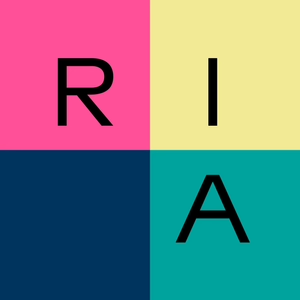
the Roberts Institute of Art
the Roberts Institute of Art
All episodes
Best episodes
Seasons
Top 10 the Roberts Institute of Art Episodes
Goodpods has curated a list of the 10 best the Roberts Institute of Art episodes, ranked by the number of listens and likes each episode have garnered from our listeners. If you are listening to the Roberts Institute of Art for the first time, there's no better place to start than with one of these standout episodes. If you are a fan of the show, vote for your favorite the Roberts Institute of Art episode by adding your comments to the episode page.
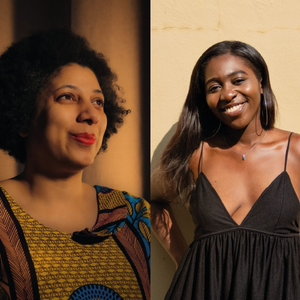
Arike Oke and Pelumi Odubanjo
the Roberts Institute of Art
10/11/21 • 40 min
Arike Oke is currently the Managing Director of the Black Cultural Archives in Brixton, which is known as the leading institutional voice on the Windrush Generation and the home of Black British history.
Independent curator, writer and researcher Pelumi Odubanjo joins Arike Oke for a discussion about how their work with archival materials creates spaces to heal, discover new stories and find other ways of living and possibilities for making art.
The pair talk to Lucy Cowling from the Roberts Institute of Art about the importance of knowledge transmission between generations and community building within Black British cultures.
NOTES
At 7 min 51 sec Arike Oke refers to the Jamaican/Scottish nurse Mary Seacole as looking after troops in the Boer War, this should be the Crimean War.
MORE INFO
This episode is part of our ‘On Togetherness’ podcast mini-series, where we invite conversations between artists and practitioners in the cultural field, exploring collaboration and how to be together in all its forms. Find previous conversations between acclaimed photographer Hrair Sarkissian and curator Michaela Crimmin, plus academics Matthew Spellberg and Richard Sommer.
Arike Oke is Managing Director for the Black Cultural Archives in Brixton. Arike has worked in cultural heritage for over 15 years, from the seminal Connecting Histories project in Birmingham, to building Wellcome Collection's archive, and co-convening Hull's first Black History Month. She is also a writer of short stories, which you can find on arikewrites.com.
Pelumi Odubanjo works as an independent curator, writer and researcher interested in diasporic black vernacular culture and image making, informed by decolonialism and black feminism. Pelumi works with artists, archives, and cultural artefacts to explore historical and contemporary links between the intersectionality of women, migration, and identity. as means to disentangle our understandings of archival practice. She was Curator in Residence at the Black Cultural Archives in 2020.
Have questions, comments or want to see more of what the Roberts Institute of Art does? Reach us via therobertsinstituteofart.com, @therobertsinstituteofart and subscribe to our newsletter!
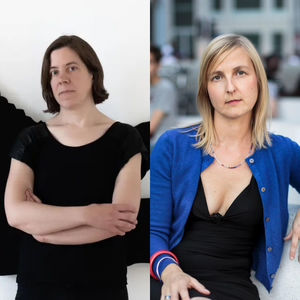
Grace Schwindt and Katleen Van Langendonck
the Roberts Institute of Art
11/09/22 • 53 min
Grace Schwindt is a German artist working with film, live performance, sculpture, and drawing. As part of Evening of Performances 2018, Grace presented The Boxer. The Boxer proposed the intimate moment of sharing physical and mental wounds as a possibility to create open social relations.
Belgian curator and academic Katleen Van Langendonck joins Grace Schwindt in conversation about Grace's practice and the crossovers between Katleen's current research into performance and the translation of the medium between visual arts and theatre.
The pair discuss the transmission of trauma and the translation of performance within different contexts with reference to Schwindt’s work. They unpick the mechanisms and methodologies used by museums and theatres to understand how each can achieve better working models when it comes to cross-disciplinary performance work.
This special edition of our 'On Togetherness' series is part of Recall: Evening of Performances (2008–2019), a year-long programme of interviews, podcasts and contributions from some of the artists who participated in the twelve editions of the celebrated Evening of Performances. Highlighting the evenings’ extraordinary legacies, we will be exploring what the next wave of contemporary performance can become with the artists who have shaped it so far.
Have questions, comments or want to see more of what the Roberts Institute of Art does? Reach us via therobertsinstituteofart.com, @therobertsinstituteofart and subscribe to our newsletter!
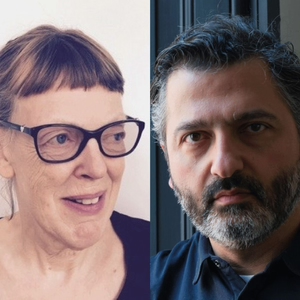
Michaela Crimmin and Hrair Sarkissian
the Roberts Institute of Art
09/27/21 • 33 min
Michaela Crimmin is an independent curator and co-director of the not-for profit agency, Culture+Conflict. For over 15 years she taught on the Royal College of Art’s curating contemporary art MA.
Hrair Sarkissian is a photographer who was brought up in Damascus and who now lives and works in London. His practice explores his own personal memories and histories and the relationship between visibility and invisibility.
In this podcast, our guests discuss Sarkissian's formative years working in his father’s studio in Damascus, the notion of home and identity and the aesthetic and political capacities of photography, especially in relation to trauma and personal and social histories.
This is the second in a new series of talks for the Roberts Institute of Art podcasts, where artists, cultural practitioners and other thinkers are invited to discuss a theme connected to our programmes and contemporary culture.
MORE INFO
We recommend you take a look at Sarkissian’s website where you can look closely at the photographic series discussed: ‘Home Sick’, ‘Unexposed', ‘Sarkissian’s Photo Centre & my father & I', and ‘Last Scene’, for example.
Michaela Crimmin works as an independent curator and is co-director of Culture+Conflict, a not-for-profit agency profiling and supporting artists whose work relates to international conflict. For over 15 years she taught on the Royal College of Art’s curating contemporary art MA, and most recently led a major EU-funded research programme that included a residency with Delfina Foundation by Noor Abuarafeh, an artist from Palestine; a forthcoming film commission that opens at Gasworks in October this year by Adam Khalil & Bayley Sweitzer; and a symposium with The Showroom and Tate co-programmed with Elvira Dyangani Ose asking to what extent can art affect change when addressing issues of migration, displacement, and access.
Previously she was Head of Arts at the Royal Society of Arts (RSA), a role that included initiating and directing the RSA Arts & Ecology Centre; and coordinating the first works of art on the Fourth Plinth, Trafalgar Square.
Hrair Sarkissian is a photographer. Born and raised in Damascus, he earned his foundational training at his father’s photographic studio, where he spent all his childhood vacations and where he worked full-time for twelve years after high school. In 2010 he completed a BFA in Photography at the Gerrit Rietveld Academie, Amsterdam. He lives and works in London since 2011. He will be showing in the British Art Show 9 (2021) and his first mid-career survey, Hrair Sarkissian: The Other Side of Silence, curated by Dr Omar Kholief, will be shown at the Sharjah Art Foundation, Bonniers Konsthall, Stockholm and the Bonnefanten, Maastricht (2021-2022).
Have questions, comments or want to see more of what the Roberts Institute of Art does? Reach us via therobertsinstituteofart.com, @therobertsinstituteofart and subscribe to our newsletter!
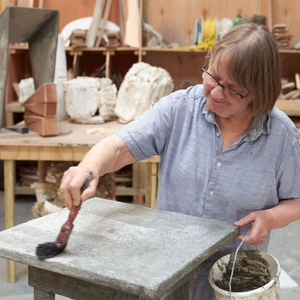
Phyllida Barlow on Bethan Huws
the Roberts Institute of Art
11/19/21 • 25 min
We invited Phyllida Barlow, whose work is featured in the David and Indrė Roberts Collection, to choose a piece from the collection as the starting point for a conversation about influences and objects of interest. She chose Bethan Huws’ Untitled, 2002.
Untitled is from Huws' Word Vitrine series and is a text-based work of sculptural form, using standard office word vitrines made from aluminium, glass, rubber and plastic letters. First created in 1999, her Word Vitrines reference Marcel Duchamp's ready-mades, though they alter this concept with the addition of an evocative text.
Barlow discusses that what drew her to Huws' work is the sentience she imbues in her sculptures. She joins Ned McConnell from her London home for a conversation about memory, the ‘performativity’ of sculpture and the difference between someone and something.
British artist Phyllida Barlow takes inspiration from her surroundings to create imposing installations that can be at once menacing and playful. Creating anti-monumental sculptures, she uses inexpensive, low-grade materials such as cardboard, fabric, plywood, polystyrene, scrim and cement. Her constructions are often testing the limits of a space whether through height, mass or volume and balance engage the audience by blocking straddling or precariously balancing in the space.
Have questions, comments or want to see more of what the Roberts Institute of Art does? Reach us via therobertsinstituteofart.com, @therobertsinstituteofart and subscribe to our newsletter!
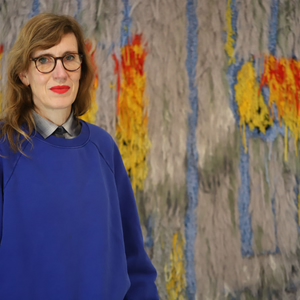
Caroline Achaintre on Berlinde De Bruyckere
the Roberts Institute of Art
12/17/20 • 16 min
Both having keen interests in the animal world, art history and mythology, Caroline Achaintre quickly gravitated to Berlinde De Brucykere when asked to choose a work from the David Roberts Collection other than her own to discuss.
De Bruyckere's Lost II (2007) is a large sculpture made from epoxy, horse skin metal and wood, where what looks like a spineless horse carcass is draped over a domestic table. Achaintre describes being drawn in by the combination of repulsion and attraction to what remains a beautifully crafted object and evocative animal.
It is the starting point for a conversation about processes and influences, which for Achaintre range from 'uncanny valley' robotics, to Japanese figurines from B films, and German Expressionist painters.
Have questions, comments or want to see more of what DRAF does? Reach us via davidrobertsartfoundation.com, @draf_art and subscribe to our newsletter!
Image of Caroline Achaintre by Jenna Barberot.
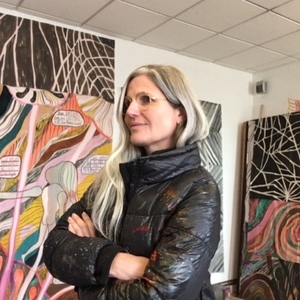
Emma Talbot on Huma Bhabha
the Roberts Institute of Art
03/18/21 • 23 min
Emma Talbot selected What is Love (2013) by Huma Bhabha when asked to pick a work from the David and Indrė Roberts Collection to discuss in relation to her own practice.
Bhabha’s painted sculpture, which could just as easily be an alien from the future or symbol of an ancient past, forms the basis of a discussion about time travel and the way both artists imbued their works with with feeling and tie the personal up with events in the wider world.
What is Love (2013) is a totemic representation of a body, at a towering 2 meters high and 30 centimeters deep. It is carved from cork from the torso down and the head and shoulders are made from small squares of Styrofoam that have a greenish hue.
Emma Talbot lives and works in London and works primarily in drawing, painting and installation. She studied at the Birmingham Institute of Art & Design and the Royal College of Art, where she is now also a painting Tutor. In March 2020 she won the eighth Max Mara Art Prize for Women, which will result in a solo exhibition at The Whitechapel Gallery in London and Collezione Maramotti in Italy, both in 2022.
Have questions, comments or want to see more of what DRAF does? Reach us via davidrobertsartfoundation.com, @draf_art and subscribe to our newsletter!
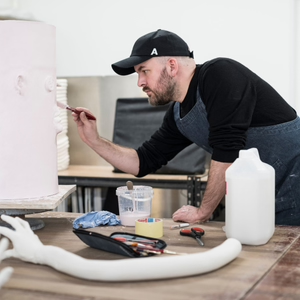
Jonathan Baldock on Niki de Saint Phalle
the Roberts Institute of Art
11/05/20 • 20 min
An artist he has long loved and admired, artist Jonathan Baldock quickly gravitated towards Niki de Saint Phalle when asked to choose a work to discuss from the David Roberts Collection. Topic of deliberation is her small sculpture Nana Danseuse made around 1972.
He is interested in both the joyous celebration of female figures and the (at times overlooked) politicized, feminist activism and trauma that is also present in de Saint Phalle's practice. There are formal crossovers in Baldock and de Saint Phalle's practices too, both being rich with references, sparking conversation about her Tarot Garden in Italy and the act of collecting "mundane things" as a child including stamps, coins, and even bird sightings.
Have questions, comments or want to see more of what DRAF does? Reach us via davidrobertsartfoundation.com, @draf_art and subscribe to our newsletter!
Image of Jonathan Baldock by Damian Griffiths.
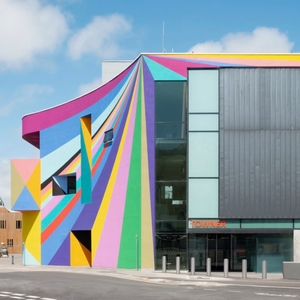
Joe Hill
the Roberts Institute of Art
06/23/20 • 42 min
DRAF Broadcasts: Podcast with Joe Hill
What does it mean to have a "living collection", or use stories from an art collection to form societies that are forward-looking? These are the types of questions Joe Hill is asking since taking the helm of Towner Eastbourne (9:55).
Towner Eastbourne has a rich history and eclectic collection. It has been shaped throughout the 20th century by artists and curators and as such has always been contemporary, tracking the contemporary as it has moved along for 100 years (from 6:04).
Hill and McConnell also discuss the importance of collaboration and turning the museum into a more communal, friendly and social space, reflecting on what role the collection and new acquisitions play within this (from 14:30).
BIO
Originally trained as an artist, Joe Hill has over ten years experience working as a director, curator and project coordinator for visual arts organisations, public commissioning and working directly with artists. Prior to his appointment at Towner Eastbourne he was Director of Focal Point Gallery in Southend-on-Sea between 2013- 2018.
If you're interested to hear more about curating, audiences and collections, be sure to listen to Episode 3 of the DRAF Broadcasts: Podcast, where Ned McConnell talks with Laura Smith, Curator at Whitechapel Gallery.
Have questions, comments or want to see more of what DRAF does? Reach us via davidrobertsartfoundation.com, @draf_art and subscribe to our newsletter!
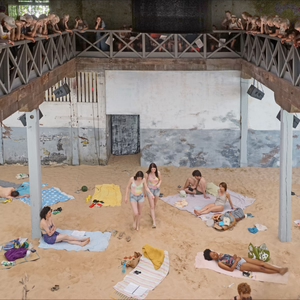
Lina Lapelytė
the Roberts Institute of Art
06/23/20 • 30 min
DRAF Broadcasts: Podcast with Lina Lapelytė
Lina Lapelytė and Ned McConnell were supposed to meet for an Artist Talk at DRAF on 18 March 2020, which was cancelled due to the COVID-19 pandemic. Following this, the podcast is a space to initially reflect on the immense changes to making, presenting, or thinking about art during lockdown. It has changed time management and pace, as well as underscoring the importance of touring and re-staging large performance works. The pair also discuss the performance that was planned for Glasgow International - similarly postponed due to the ongoing health crisis.
Lapelytė, together with collaborators Vaiva Grainytė (libretto) and Rugilė Barzdžiukaitė (director), composed an opera called Sun & Sea (Marina). This was their second collaboration together, after Have a Good Day!, created between 2011 and 2013 which still tours today. Sun & Sea (Marina) was presented at the Lithuanian pavilion during the 2019 Venice Biennale, in a project curated by Lucia Pietroiusti, and won the Golden Lion for best pavilion, one of the festival's top two awards.
Taking this big project as a departure point, McConnell and Lapelytė trace her practice back through earlier operatic and music-based works such as Have A Good Day! and Candy Shop. Often working with non-classically trained performers, composed music and visual art elements, Lapelytė asserts that staging “improvised music can be like abstract painting”, whilst making an opera equates to other kinds of painting (21:01).
BIO
Lina Lapelytė (b.1984, Lithuania) is an artist living and working in London and Vilnius. She holds a BA in classical violin (2006), BA in Sound Arts (2009) and MA in Sculpture from the Royal College of Art, London (2013). Her performance-based practice is rooted in music and flirts with pop culture, gender stereotypes, aging and nostalgia. Throughout her artistic career, Lapelytė has explored various forms of performativity, crossing genre boundaries while entwining folk rituals with popular music and opera formats, frequently using stylized expression, grotesque and conceptual musicality.
Have questions, comments or want to see more of what DRAF does? Reach us via davidrobertsartfoundation.com, @draf_art and subscribe to our newsletter!

Matthew Spellberg and Richard Sommer
the Roberts Institute of Art
09/16/21 • 46 min
Matthew Spellberg is a scholar whose topic of study is the comparative history of dreaming—how dreams are experienced, shared, and made use of in different cultures. Originally trained as an architect, Professor Richard Sommer is interested in where politics and design meet. He writes on monument making, urbanism and time-based architecture.
The pair sit down to discuss dream sharing and the important role psychic spaces play in how we live and work together, mutual interests that have brought them to collaborate on exhibitions and events.
This is the first in a new series of talks on the podcast, where artists, cultural practitioners and other thinkers are invited to discuss a theme connected to our programme, with the duo reflecting on how that influences contemporary culture.
Have questions, comments or want to see more of what the Roberts Institute of Art does? Reach us via therobertsinstituteofart.com, @therobertsinstituteofart and subscribe to our newsletter!
MORE INFO
Glossary:
Circadian rhythms: physical, mental, and behavioural changes that follow a 24-hour cycle.
Spelunking: cave diving.
Ongees: one of the last hunter-gatherer cultures in the Bay of Bengal.
Dialectic: a discussion between two or more people holding different points of view about a subject but wishing to establish the truth through reasoned argumentation.
Agoraphobia: fear of being in situations where escape might be difficult or that help wouldn't be available if things go wrong. Commonly thought of as fear of open spaces.
Useful links:
Richard: New Circadia
Matthew: On Dream Sharing and Its Purpose
Show more best episodes

Show more best episodes
FAQ
How many episodes does the Roberts Institute of Art have?
the Roberts Institute of Art currently has 27 episodes available.
What topics does the Roberts Institute of Art cover?
The podcast is about Culture, Conversation, Artist, London, Career, Art, Visual Arts, Conversations, Discussion, Performance, Contemporary Art, Research, Podcasts, Talk, Studio, Arts, Business, Visual, Careers and Review.
What is the most popular episode on the Roberts Institute of Art?
The episode title 'Close Looking: Marina Warner on Paula Rego' is the most popular.
What is the average episode length on the Roberts Institute of Art?
The average episode length on the Roberts Institute of Art is 32 minutes.
How often are episodes of the Roberts Institute of Art released?
Episodes of the Roberts Institute of Art are typically released every 14 days, 15 hours.
When was the first episode of the Roberts Institute of Art?
The first episode of the Roberts Institute of Art was released on Jun 23, 2020.
Show more FAQ

Show more FAQ